Were The Chinese The Worlds Greatest Explorers?

Peregrina's Journey
Peter and Margie Benziger
Wed 23 Nov 2011 12:21
WERE THE CHINESE THE
WORLDS GREATEST EXPLORERS?
By Peter Benziger
Recently, my
views of sea-based exploration of the world were challenged.
In Melaka,
Malaysia, we visited a museum dedicated to Chinese trade and sea exploration. Much
of the focus was on the years 1421-1423 and the exploits of Admiral Zeng He.
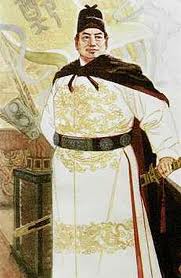
At that
time, the entire Chinese fleet consisted of some 3,800 ships. Among the fleet,
there were 250 long-distance “treasure ships.”
The “treasure ships” were immense vessels, over 400 feet long and 150
feet wide. For comparison, Christopher Columbus’ ship the Santa Maria was 85
feet long. The Treasure Ships were capable of transiting vast oceans carrying
huge amounts of people and cargo over large distances.
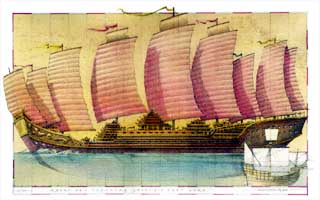
Each
treasure ship consumed the wood of three hundred acres of prime teak forest. They
contained water tight bulkheads and were designed to remain afloat even if two
compartments were flooded after being punctured by coral or ice. These mighty merchants roamed far and wide
trading silk, spices, jade and porcelain.
The ships
could remain at sea for over three months and cover at least 4,500 miles
without making landfall to replenish food or water because separate grains
ships and water tankers sailed with them. At this time, the Chinese were
centuries ahead of Europe and the ships were armed with gunpowder weapons,
brass and iron cannon, mortars, flaming arrows and exploding shells.
The Chinese
understood the danger of scurvy long before other nations. On the ships, they
grew soya beans in tubs and sprouted ‘yellow curls’ from the green beans to
increase the content of ascorbic acid, riboflavin and Vitamin C. These fresh
vegetables, combined with large supplies of citrus fruits, protected the crews
from scurvy.
Emperor Zhu
Di, known as the Son of Heaven, sent out Chinese fleets as emissaries from
mainland China to develop trading partnerships and extend the Chinese empire.
The fleet
would sail in the “Flying Swallow Formation.”
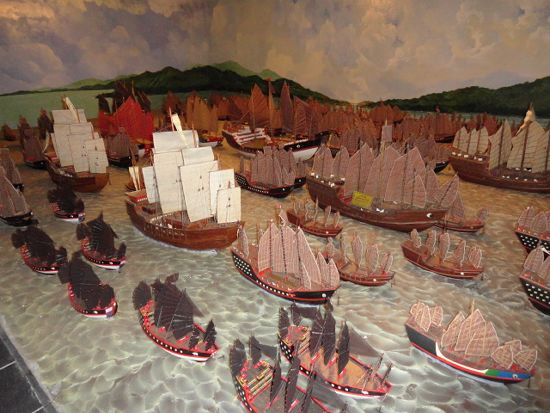
A description in the museum reads:
“Over the vast seas, the fleet was formed
like a swallow. 4 flagships together with 12 other ‘treasure ships’ occupied
the central position of the fleet. 200
combat-billet ships in 4 camps were stationed on both sides of the array of
flagships: 45 battleships sailed ahead. 100 horse ships followed in the rear;
while another 45 battleships sailed on the left. The largest treasure ship had
9 masts and 12 sails, and even the smallest one had 3 masts. When the order was
given, all the sails would be raised and the fleet would sail like a flying
swallow."
Emperor Zhu
Di, appointed his trusted eunuch, Zheng He, as Admiral of the fleets. Eunuchs played an important role throughout
Chinese history. They served in high-ranking positions in every facet of
business and government. In the royal
palaces, they served as trusted advisors while, obviously, posing no threat to
the hundreds of royal “consorts” to the Emperor. Surprisingly, eunuchs were intensely loyal to
the emperors who had authorized their mutilation.
The
following description of castration is provided by the museum. [Please note:
This section is NOT for the squeamish!]
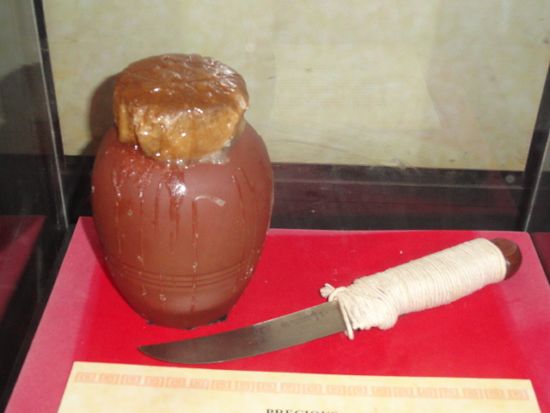
“It costs six taels of silver to
perform a castration in Beiping.
The candidate – usually a young boy –
is held down by three men. A small curved knife is then used to cut off the
penis and testicles. A metal plug is inserted and the wound is bandaged. He
does not eat or drink for three painful days. Then the plug is pulled out and
he is allowed to urinate. If he does, he is out of danger. If not, then he will
die.
His sexual organs, called his “bao”
or “precious” are preserved in a sealed jar. He is said to have his “bao” in a
temple”.
In addition
to Zheng He, many of the commanders of the Emperor’s ships were eunuchs. They
were all very accomplished sailors and outstanding leaders.
The Chinese
were already far more advanced in navigation than their European counterparts
who would follow. In the museum, the
following picture and description appears
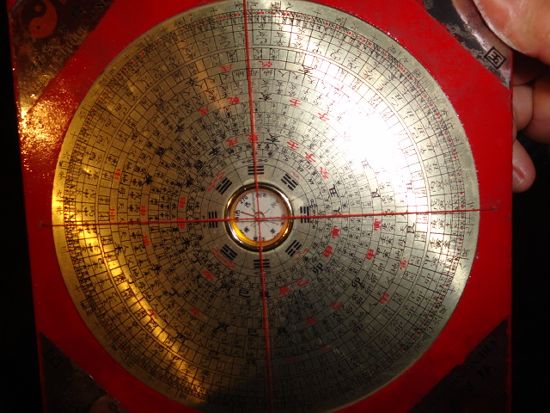
“The magnetic compass is one of the
four major Chinese inventions for the world. It consists of a magnetized pointer free to
align itself with the Earths’ magnetic field for reference of direction. This
was the compass used by Zeng He. The
invention of the magnetic compass changed, forever, the history of navigation.”
While the
compass gave the sailing master a direction to sail, the real challenge was to
know exactly where you were. Most
countries around the world first learned to use the Pole Star to determine
latitude. The following diagram shows how the sighting of the Pole Star (over
the North Pole) could easily be translated into a latitude degree by
measurement of the angle.

When
Christopher Columbus, sailed in 1492, he sailed westward along a specific latitude by keeping the angle of the
pole star constant. But, as far as we
know, he had no accurate way of calculating longitude. The Chinese claim to have devised a longitude
calculation three centuries BEFORE Columbus sailed.
In 1424,
Emperor Zhu Di died and, with his death, the Chinese interest in international
travel started to wane. Over the next decade, all voyages of the treasure
fleets were stopped and edicts banned overseas trade and travel. At one point, to prevent any foreign trade or
contact, a strip of land along the southern coast, 700 miles long and 30 miles
wide, was devastated, burnt and the population moved inland. Complete xenophobia set in and the shipyards,
treasure ships, sailing logs and all official records of Zheng He’s voyages
were systematically destroyed. China effectively closed the door on the world
outside its borders.
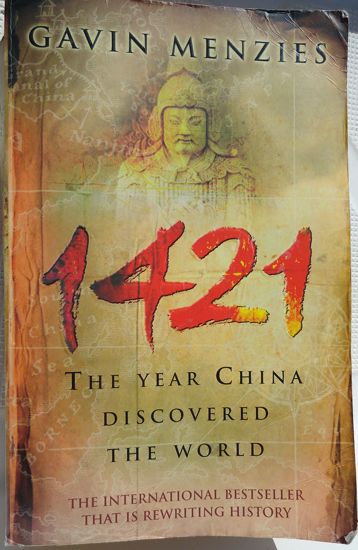
This book,
by Gavin Menzies, reached best seller status around the world and has created a
new interest in the history of Chinese sea exploration. It is a fascinating read. The title “1421, The Year China Discovered the
World” is appropriate since the following claims are made in the book.
- Four huge Chinese fleets
circumnavigated the world between 1421 and 1423. These fleets comprised more
than 800 vessels. These fleets charted the world.
-Sailors and concubines from those
great fleets settled in Malaysia, India, Africa, North and South America,
Australia, New Zealand and on islands across the Pacific.
-The first European explorers
had maps showing where they were going before they set sail. They met Chinese settlers when they arrived
in the New World.
- China, not Europe, discovered and settled
the New World. European “discoveries”
relied on China leading the way.
The
following map appears in the book ‘1421’ purportedly charting the Chinese world
exploration
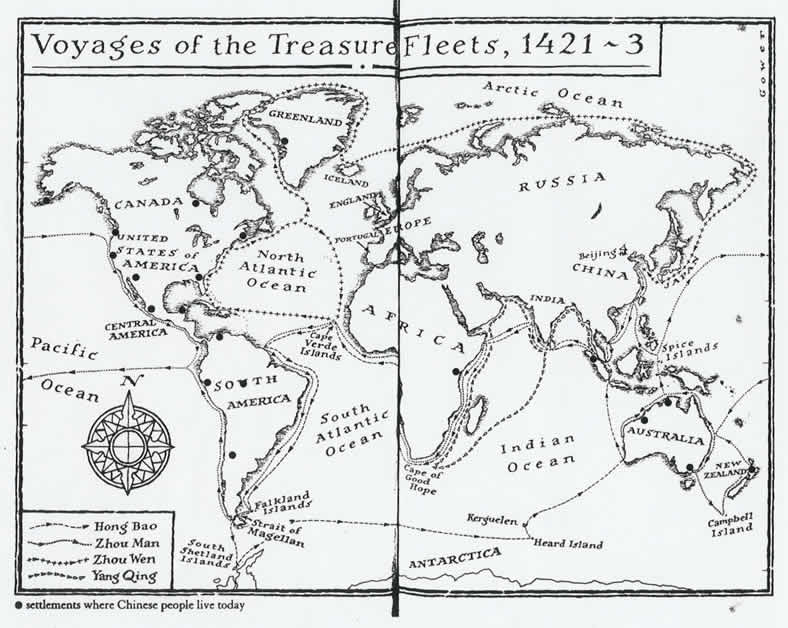
The author
has amassed an impressive amount of evidence including wrecks of the Chinese
sailing ships, human DNA tests, genetic plant identification and relics of
Chinese produced trade goods.
In the book,
he notes…
“To assert the primacy of Chinese
exploration of the New World and Australia is not to denigrate the achievements
and memories of Dias, Columbus, Magellan and Cook…it is to honor other men who
have been allowed to languish in obscurity for too long. These remarkable
Chinese admirals rounded the Cape of Good Hope sixty-six years before Dias,
passed through the Straits of Magellan ninety-eight years before Magellan, surveyed
Australia three centuries before Cook
and America seventy years before Columbus.”
Onboard
Peregrina, we devoured this book with great zest as we have sailed along some
of the routes described. Read it
yourself, but only if you are open to having surprising theories and validation
challenge your current thinking.
Safe seas
and fair winds
Peter and Margie
Peregrina
Malaysia
--------------------------------------------
http://blog.mailasail.com/peregrina